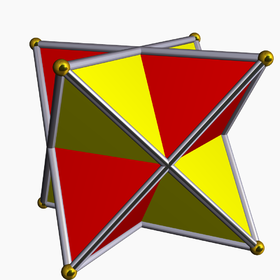
Back Estel octangle Catalan Sterntetraeder German Stelookangulopluredro Esperanto Estrella octángula Spanish Octangle étoilé French תמניון מכוכב HE Stella octangula Italian 星型八面体 Japanese Stella octangula Polish Octaedro estrelado Portuguese
| Stellated octahedron | |
|---|---|
 Seen as a compound of two regular tetrahedra (red and yellow) | |
| Type | Regular compound |
| Coxeter symbol | {4,3}[2{3,3}]{3,4}[1] |
| Schläfli symbols | {{3,3}} a{4,3} ß{2,4} ßr{2,2} |
| Coxeter diagrams | |
| Stellation core | Octahedron |
| Convex hull | Cube |
| Index | UC4, W19 |
| Polyhedra | 2 tetrahedra |
| Faces | 8 triangles |
| Edges | 12 |
| Vertices | 8 |
| Dual | Self-dual |
| Symmetry group Coxeter group |
Oh, [4,3], order 48 D4h, [4,2], order 16 D2h, [2,2], order 8 D3d, [2+,6], order 12 |
| Subgroup restricting to one constituent |
Td, [3,3], order 24 D2d, [2+,4], order 8 D2, [2,2]+, order 4 C3v, [3], order 6 |

The stellated octahedron is the only stellation of the octahedron. It is also called the stella octangula (Latin for "eight-pointed star"), a name given to it by Johannes Kepler in 1609, though it was known to earlier geometers. It was depicted in Pacioli's De Divina Proportione, 1509.[2]
It is the simplest of five regular polyhedral compounds, and the only regular compound of two tetrahedra. It is also the least dense of the regular polyhedral compounds, having a density of 2.
It can be seen as a 3D extension of the hexagram: the hexagram is a two-dimensional shape formed from two overlapping equilateral triangles, centrally symmetric to each other, and in the same way the stellated octahedron can be formed from two centrally symmetric overlapping tetrahedra. This can be generalized to any desired amount of higher dimensions; the four-dimensional equivalent construction is the compound of two 5-cells. It can also be seen as one of the stages in the construction of a 3D Koch snowflake, a fractal shape formed by repeated attachment of smaller tetrahedra to each triangular face of a larger figure. The first stage of the construction of the Koch Snowflake is a single central tetrahedron, and the second stage, formed by adding four smaller tetrahedra to the faces of the central tetrahedron, is the stellated octahedron.
- ^ H.S.M. Coxeter, Regular Polytopes, (3rd edition, 1973), Dover edition, ISBN 0-486-61480-8, 3.6 The five regular compounds, pp.47-50, 6.2 Stellating the Platonic solids, pp.96-104
- ^ Barnes, John (2009), "Shapes and Solids", Gems of Geometry, Springer, pp. 25–56, doi:10.1007/978-3-642-05092-3_2, ISBN 978-3-642-05091-6.
© MMXXIII Rich X Search. We shall prevail. All rights reserved. Rich X Search